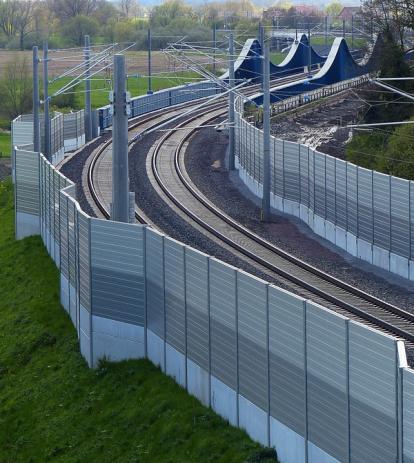
Cultural heritage: Indigenous and cultural heritage values driving sustainable development
by Flavia Kiperman
View post

Transportation noise is a frequent source of frustration for residents and a common cause of complaints in many communities. In a growing city like Calgary, it is critical for developers to understand how noise regulations can impact their residential development projects, especially with the increased demand for new homes in Calgary and across Alberta.
The City of Calgary's Surface Transportation Noise Policy plays a key role in shaping how new developments are planned and designed, helping to mitigate the impact of unwanted sound from nearby road and railways and protect residents’ quality of life.
For developers planning residential projects near major transportation corridors, it is essential to address sound issues early in the design phase to avoid complications down the road. Not considering or complying with the Surface Transportation Noise Policy could lead to delays, additional costs, withheld permit approvals, or dissatisfaction among future residents. This is not something you should leave until the last minute. Being proactive will save time, costs, and headaches down the line.
This article explains the City of Calgary's Surface Transportation Noise Policy and offers developers practical guidance on how to comply to avoid costly mistakes and ensure the long-term comfort of future residents concerning transportation noise.
The Surface Transportation Noise Policy was established to manage and mitigate sound from transportation sources such as road and rail traffic and prescribes the conditions and requirements for sound mitigation for developments adjacent to these transportation corridors. An approved sound level study conducted in accordance with the Surface Transportation Noise Policy is required for development permitting approval.
In the policy, applicable sound parameters and descriptors are discussed, corresponding design criteria are established, and responsibilities for mitigation are defined. Understanding and integrating the requirements of the policy into your project’s design early-on not only facilitates compliance but can also enhance the marketability of developments by offering quieter, more livable spaces.

The Surface Transportation Noise Policy applies to all existing and future residential development areas in Calgary. The policy sets sound level criteria and assessment locations for developments located near different types of transportation corridors. Based on these guidelines, relevant control measures, like sound barriers, are specified.
For existing developments, compliance with the Surface Transportation Noise Policy is assessed through sound level measurements and monitoring to evaluate eligibility for the City of Calgary’s Noise Barrier Retrofit Program.
For proposed developments, a theoretical assessment is conducted to determine whether sound mitigation measures are warranted to reduce future predicted traffic sound levels in the outdoor areas around future single-family, townhome, and multi-family developments. Typically, predicted sound levels for future residential developments are assessed using 3D sound prediction software such as SoundPLAN or CadnaA.
When a residential development is proposed adjacent to existing or future transportation corridors, the developer is responsible for providing a Noise Impact Analysis (NIA) study. The NIA should be conducted by a qualified acoustic consultant and is submitted to the City’s Transportation Department for review and approval.
Applicable areas requiring an NIA study consist of residential developments proposed adjacent to skeletal roads, arterial streets and parkways, light rail transit corridors, and other rail lines. Current roadway classifications can be viewed in the City of Calgary Road and Street Network Map.
The Surface Transportation Noise Policy does not apply to developments along roadways identified as urban or neighbourhood boulevards in the Calgary Transportation Plan. Sound mitigation in these areas is recommended to be achieved through appropriate architectural practices, such as upgraded facades and glazing. However, no specifications for minimum facade sound isolation performance or indoor sound level criteria are defined in the Surface Transportation Noise policy.
The City of Calgary specifies the Design Noise Level (DNL) limits that need to be evaluated in the outdoor leisure areas of developments. Under the Surface Transportation Noise Policy, an outdoor leisure area is defined as “a ground level area such as a yard, patio or common area allocated outside a multi-residential building. For walk-out style lots adjacent to designated truck routes, the outdoor leisure area includes a rear deck that is at the same elevation as the main floor.”
Sound levels are assessed 1.5 m above the ground for standard lots at a distance of 3.0 m from the house or 4.5 m from the property line. For buildings two stories or higher (where balconies are often considered the outdoor leisure area), the Surface Transportation Noise Policy recommends that mitigation be provided individually through architectural treatments.
In all cases, the applicable DNL limit depends on whether the adjacent transportation corridor is defined as a truck route. Existing truck routes can be identified using the City of Calgary Truck Route Map. The DNL limit in residential outdoor leisure areas is either:
The A-weighted sound level, measured in units of dBA, is a broadband measurement of sound over all frequencies with higher weighting given to mid- and higher-frequencies. This provides a reasonable approximation of people's perception of the loudness or annoyance of transportation noise at moderate levels.
The Surface Transportation Noise Policy requires an assessment of sound levels over a 24-hour period for developments adjacent to non-truck routes. To account for higher sound levels during peak traffic hours such as rush hour, the Surface Transportation Noise Policy prescribes a statistical indicator, L10, to be assessed over the worst-case hour for developments adjacent to truck routes. This descriptor indicates that, during the peak hour, the sound level limit of 65 dBA cannot be exceeded for 10% of the hour. In practice, this means that the sound level should not exceed 65 dBA for 6 total, but not necessarily continuous, minutes of the hour.
For proposed developments, future predicted sound levels are based on the 10-year forecasted traffic volumes for non-truck routes or the higher of 10- or 20-year forecasted traffic volumes for truck routes. Future forecasted traffic data to be used in the predictive sound model is typically obtained from the City’s Transportation Data department by the acoustic consultant on behalf of the developer.

Though the Surface Transportation Noise Policy recommends architectural treatments to mitigate traffic sound levels in some instances, it does not require an explicit assessment of façade sound isolation performance or predicted interior sound levels. Similarly, The National Building Code – Alberta Edition, only prescribes a minimum sound isolation performance for assemblies separating a dwelling unit from every other space in a building in which noise may be generated. Learn more about the National Building Code and its limitations in SLR’s Insights article.
To assess outdoor to indoor sound transmission, one may consider the criteria established in Canada Mortgage and Housing Corporation’s Road and Rail Noise: Effects on Housing documentation, which defines maximum acceptable levels of road and rail traffic noise in interior dwelling areas, such as bedrooms, living rooms, and dining rooms. For developments adjacent to railways, The Federation of Canadian Municipalities/The Railway Association of Canada’s Guidelines for New Development in Proximity to Railway Operations , which prescribes similar interior sound level limits, is commonly considered. Outdoor to indoor sound transmission is often assessed in accordance with the methodology established in the National Research Council of Canada’s Building Practice Note No. 56 – Controlling Sound Transmission Into Buildings.
An acoustic consultant can work with you to consider outdoor to indoor sound transmission and recommend control measures to improve interior quality of life for future residents.
When a developer constructs a residential development adjacent to an applicable transportation corridor, and if the expected sound levels exceed the City's DNL limit, the developer is responsible for providing sound mitigation at their expense. The choice of attenuation measure is left to the developer, subject to City approval.
This mitigation typically takes the form of a concrete or sufficiently substantial wood sound barrier along the affected property line of the development. For some multi-family developments, attenuation can take the form of upgraded or enclosed ground floor patio structures. When a barrier is implemented, the City reimburses the cost of a 1.8 meter high chain link fence for the length of the sound barrier required.
To maximize benefit/cost of sound mitigation, the Surface Transportation Noise Policy recommends that mitigation be designed and constructed to achieve a minimum 5 decibel reduction and a preferred target reduction of 10 decibels. Achieving this level of attenuation must be technically, economically, and administratively feasible, where feasibility is determined when City Administration reviews the noise mitigation design, and all alternative measures have been evaluated.

1. Engage an Acoustic Consultant to Begin the Noise Impact Analysis (NIA) Process
Engaging an acoustic consultant early in the planning phase allows the NIA and its recommendations to be more easily incorporated into the development’s design process. Mitigation in the form of property line sound barriers can often conflict with planned pathways and landscaping and should therefore be accounted for as early as possible.
2. Evaluate Mitigation Options
If the NIA indicates that predicted future sound levels exceed the Surface Transportation Noise Policy Design Noise Level limits, developers must incorporate mitigation measures for compliance. Common mitigation measures include:
3. Approval from the City of Calgary
The City’s Transportation Department will review the development’s NIA methodology, results, and recommendations for compliance, and will ultimately provide approval for the project. In some cases, the city may provide input on acceptable mitigation measures or additional considerations, especially for high-density developments or large projects adjacent to major transportation routes.
4. Design for Livability
Unfortunately, the Surface Transportation Noise Policy only prescribes design criteria for outdoor, ground floor areas and does not specify requirements for upper floors or interior spaces. Beyond meeting compliance standards, architectural sound mitigation enhances the livability and attractiveness of residential developments.
Developers should work with their acoustic consultant to consider how further sound control measures may contribute to the overall quality of life for future residents. For indoor spaces, thoughtful layout and location of rooms, upgraded glazing, and well-designed building envelopes can make a property more desirable to potential buyers or tenants.
The City of Calgary’s Surface Transportation Noise Policy is an essential framework for managing road and rail traffic sound levels in residential developments near transportation corridors. For developers, understanding and addressing these requirements early in the project lifecycle is crucial to avoiding non-compliance, costly redesigns, and resident dissatisfaction.
By conducting a thorough Noise Impact Analysis study, exploring effective mitigation strategies, and collaborating closely with an acoustic consultant and the City, developers can create residential spaces that not only meet regulatory standards but also offer a higher quality of life for residents. Investing in proactive sound control measures today helps future-proof your development in a city where transportation noise is a constant challenge.
Need a traffic NIA study for your proposed development? Get in touch with us today.


by Flavia Kiperman

by Jasper Schrijvers , Matthew Hoare

by Clodagh Connolly, Nicola Inge, Andres Schottlaender